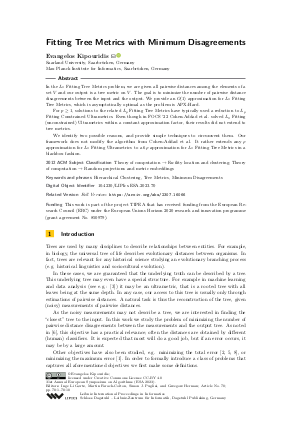Fitting Tree Metrics with Minimum Disagreements
Author
Evangelos Kipouridis 
-
Part of:
Volume:
31st Annual European Symposium on Algorithms (ESA 2023)
Part of: Series: Leibniz International Proceedings in Informatics (LIPIcs)
Part of: Conference: European Symposium on Algorithms (ESA) - License:
 Creative Commons Attribution 4.0 International license
Creative Commons Attribution 4.0 International license
- Publication Date: 2023-08-30
File

PDF
LIPIcs.ESA.2023.70.pdf
- Filesize: 0.63 MB
- 10 pages
Document Identifiers
Related Versions
- Full Version https://arxiv.org/abs/2307.16066
Subject Classification
ACM Subject Classification
- Theory of computation → Facility location and clustering
- Theory of computation → Random projections and metric embeddings
Keywords
- Hierarchical Clustering
- Tree Metrics
- Minimum Disagreements
Metrics
- Access Statistics
-
Total Accesses (updated on a weekly basis)
0Document
0Metadata
Abstract
In the L₀ Fitting Tree Metrics problem, we are given all pairwise distances among the elements of a set V and our output is a tree metric on V. The goal is to minimize the number of pairwise distance disagreements between the input and the output. We provide an O(1) approximation for L₀ Fitting Tree Metrics, which is asymptotically optimal as the problem is APX-Hard. For p ≥ 1, solutions to the related L_p Fitting Tree Metrics have typically used a reduction to L_p Fitting Constrained Ultrametrics. Even though in FOCS '22 Cohen-Addad et al. solved L₀ Fitting (unconstrained) Ultrametrics within a constant approximation factor, their results did not extend to tree metrics. We identify two possible reasons, and provide simple techniques to circumvent them. Our framework does not modify the algorithm from Cohen-Addad et al. It rather extends any ρ approximation for L₀ Fitting Ultrametrics to a 6ρ approximation for L₀ Fitting Tree Metrics in a blackbox fashion.
Cite As Get BibTex
Evangelos Kipouridis. Fitting Tree Metrics with Minimum Disagreements. In 31st Annual European Symposium on Algorithms (ESA 2023). Leibniz International Proceedings in Informatics (LIPIcs), Volume 274, pp. 70:1-70:10, Schloss Dagstuhl – Leibniz-Zentrum für Informatik (2023)
https://doi.org/10.4230/LIPIcs.ESA.2023.70
BibTex
@InProceedings{kipouridis:LIPIcs.ESA.2023.70,
author = {Kipouridis, Evangelos},
title = {{Fitting Tree Metrics with Minimum Disagreements}},
booktitle = {31st Annual European Symposium on Algorithms (ESA 2023)},
pages = {70:1--70:10},
series = {Leibniz International Proceedings in Informatics (LIPIcs)},
ISBN = {978-3-95977-295-2},
ISSN = {1868-8969},
year = {2023},
volume = {274},
editor = {G{\o}rtz, Inge Li and Farach-Colton, Martin and Puglisi, Simon J. and Herman, Grzegorz},
publisher = {Schloss Dagstuhl -- Leibniz-Zentrum f{\"u}r Informatik},
address = {Dagstuhl, Germany},
URL = {https://drops.dagstuhl.de/entities/document/10.4230/LIPIcs.ESA.2023.70},
URN = {urn:nbn:de:0030-drops-187233},
doi = {10.4230/LIPIcs.ESA.2023.70},
annote = {Keywords: Hierarchical Clustering, Tree Metrics, Minimum Disagreements}
}
Author Details
Funding
This work is part of the project TIPEA that has received funding from the European Research Council (ERC) under the European Unions Horizon 2020 research and innovation programme (grant agreement No. 850979).
References
-
Richa Agarwala, Vineet Bafna, Martin Farach, Mike Paterson, and Mikkel Thorup. On the approximability of numerical taxonomy (fitting distances by tree metrics). SIAM J. Comput., 28(3):1073-1085, 1999. Announced at SODA 1996.

-
Nir Ailon and Moses Charikar. Fitting tree metrics: Hierarchical clustering and phylogeny. SIAM J. Comput., 40(5):1275-1291, 2011. Announced at FOCS 2005.

-
Gunnar E. Carlsson and Facundo Mémoli. Characterization, stability and convergence of hierarchical clustering methods. J. Mach. Learn. Res., 11:1425-1470, 2010.

-
Moses Charikar, Venkatesan Guruswami, and Anthony Wirth. Clustering with qualitative information. J. Comput. Syst. Sci., 71(3):360-383, 2005. Announced at FOCS 2003.

-
Vincent Cohen-Addad, Debarati Das, Evangelos Kipouridis, Nikos Parotsidis, and Mikkel Thorup. Fitting distances by tree metrics minimizing the total error within a constant factor. In 62nd IEEE Annual Symposium on Foundations of Computer Science, FOCS 2021, Denver, CO, USA, February 7-10, 2022, pages 468-479. IEEE, 2021.

-
Vincent Cohen-Addad, Chenglin Fan, Euiwoong Lee, and Arnaud de Mesmay. Fitting metrics and ultrametrics with minimum disagreements. In 63rd IEEE Annual Symposium on Foundations of Computer Science, FOCS 2022, Denver, CO, USA, October 31 - November 3, 2022, pages 301-311. IEEE, 2022.

-
Martin Farach, Sampath Kannan, and Tandy J. Warnow. A robust model for finding optimal evolutionary trees. Algorithmica, 13(1/2):155-179, 1995. Announced at STOC 1993.

-
Boulos Harb, Sampath Kannan, and Andrew McGregor. Approximating the best-fit tree under l_p norms. In APPROX-RANDOM, pages 123-133, 2005.

-
M.S. Waterman, T.F. Smith, M. Singh, and W.A. Beyer. Additive evolutionary trees. Journal of Theoretical Biology, 64(2):199-213, 1977.

